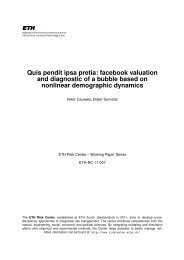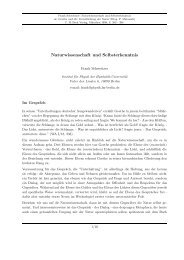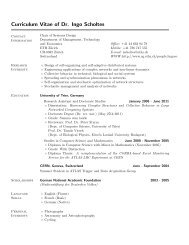Using Laboratory Experiments to Study Law and Crime - Chair of ...
Using Laboratory Experiments to Study Law and Crime - Chair of ...
Using Laboratory Experiments to Study Law and Crime - Chair of ...
You also want an ePaper? Increase the reach of your titles
YUMPU automatically turns print PDFs into web optimized ePapers that Google loves.
These experiments provide evidence that incentives (punishments for criminals <strong>and</strong>rewards for enforcers) not only have direct effects on behavior; they also have indirect effects.Because criminals <strong>and</strong> control agents have opposing interests, each is sensitive <strong>to</strong> the incentives<strong>of</strong> the other. They change their behaviors in response <strong>to</strong> the behaviors <strong>of</strong> others. But the resultsalso suggest that people are not as sensitive as the theory would predict – they are slow <strong>to</strong> updatetheir perceptions.Evidence from the field shows inconsistent results for the effect <strong>of</strong> punishment severityon crime. The labora<strong>to</strong>ry experiments described here explore one possible set <strong>of</strong> mechanismsthat may help <strong>to</strong> explain these different results. These experiments manipulate the severity <strong>of</strong>punishment <strong>and</strong> the incentives for law enforcers <strong>and</strong> accurately measure the behaviors <strong>of</strong> bothcitizens <strong>and</strong> enforcers. Because the causal fac<strong>to</strong>rs are manipulated, <strong>and</strong> subjects are r<strong>and</strong>omlyassigned <strong>to</strong> an experimental condition, evidence <strong>of</strong> causal relations is clear. The labora<strong>to</strong>ryexperiments provide evidence <strong>of</strong> mechanisms relevant <strong>to</strong> arguments in the criminologicalliterature – that experience with enforcement can lead people <strong>to</strong> update their expectations <strong>of</strong>enforcement <strong>and</strong>, in turn, <strong>to</strong> reduce their criminal behavior. They provide evidence <strong>of</strong>mechanisms that can help <strong>to</strong> explain the discrepancy between studies that compare policychanges <strong>and</strong> crime rates with those that ask respondents about their perceptions <strong>of</strong> enforcement<strong>and</strong> their own criminal activity.THE EXPRESSIVE POWER OF LAWTwo prominent approaches explain why people obey the law. One (as in the experimentsabove) explains obedience in terms <strong>of</strong> sanctions. <strong>Law</strong> discourages certain behaviors bythreatening punishment. A second focuses on legitimacy (Tyler, 1990). Richard McAdams <strong>and</strong>Janice Nadler propose a third mechanism through which law may have effects. They argue thatthe law has expressive effects. That is, it provides a focal point that helps people <strong>to</strong> coordinatetheir behavior.20







